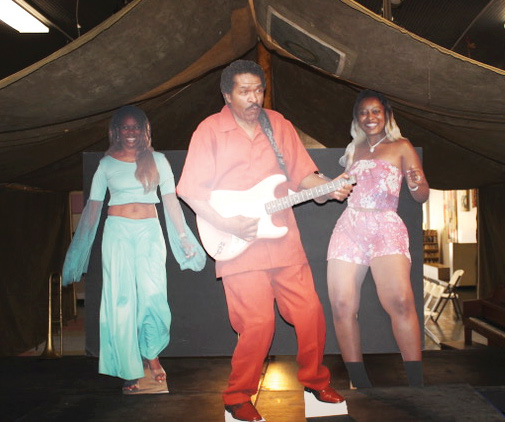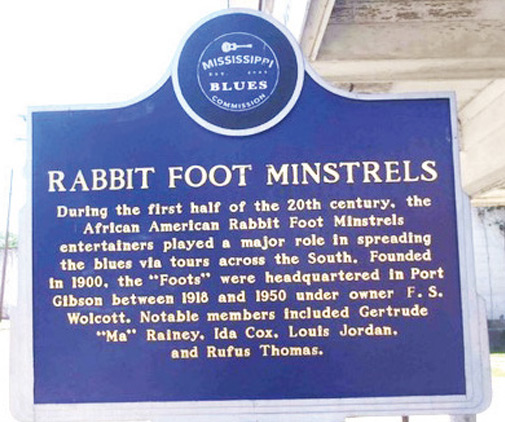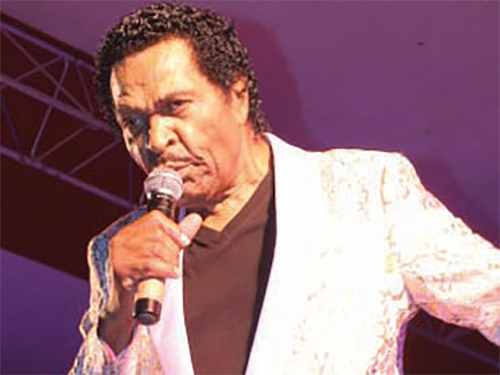

If you have ever seen a Bobby Rush Show & Revue, you were amazed by his showmanship, artistry, talent, slapstick comedy, and “them girls”. His show is like no other.
Bobby Rush is not your traditional Bluesman, and after 374 records, he won his first Grammy Award at 83-years-old for “Porcupine Meat” in 2017. He’s traveled over 250 days per year pre-pandemic. Blues music is not what’s trending on the internet, but everyone knows Blues is the backbone of American music. Willie Dixon, another Grammy Award-winning Mississippi Bluesman, said, “The Blues are the roots, and the other music is the fruits.”
Rush is considered by many to be the last “Rabbit Foot Minstrel” because of his stage presence and the type of show he puts on. This performance style dates back to the days of the early minstrel shows of the 1800s-1900s that toured the South known as the Chitlin’ Circuit – a string of Black-owned nightclubs, two- or three-room jook houses, and grocery stores, that turned into jook joints by night, catered to Black entertainers operating outside of segregated mainstream establishments. Bobby Rush is known as the “King of the Chitlin’ Circuit.”
The early minstrel shows were comprised of almost any kind of act, such as a jig band, an orchestra, chorus line/shake dancers, comedians, jugglers, blues and gospel singers, acrobats, tap dancers, and just about any type of performing act one could imagine. Back in the days of the minstrel shows, operators and managers had certain criteria to follow that made the shows more appealing to white audiences. Many of the dancers/chorus line girls had to be of a certain skin tone. The African American chorus line girls had to pass the “Brown Paper Bag” test, meaning their skin tone couldn’t be any darker than that of a brown paper bag.
Most early minstrel shows included acts that appeared in blackface. Both Black and white performers appeared in blackface, which was a permanent fixture of minstrel shows in the North, South, and Europe. Blackface was first performed in the 1830s by Thomas Dartmouth Rice, known as the “Father of Minstrelsy” who created the character Jim Crow based on a Black man he once saw dancing. Blackface minstrelsy became the national artform by 1848 but was replaced by white Vaudeville at the turn of the 20th Century. Bert Williams and George Walker, early minstrel show performers who infused political commentary into their comedic routines, offered a more intelligent representation of African Americans. They are probably the most famous African Americans who performed in Vaudeville.
The most famous Rabbit Foot Minstrel Show was owned by Pat Chappelle, a Black man who operated and managed an all-Black cast for several years prior to selling his show in 1910 to F.S. Walcott, a white man. Chappelle was highly regarded as the creator of the Rabbit Foot Show, naming it as such because he was lucky to have operated as an independent Black man for several years, much to the chagrin of the white business populous. The rabbit’s foot has long been a symbol of luck within the Black intracultural society. Wolcott’s shows featured Black and white actors appearing in skits with their faces painted with black coal/shoe polish and burnt cork with large red-lip caricatures.
African Americans also appeared in these types of shows as an entry into the entertainment industry, which was an alternative to working in the cotton fields on plantations for nothing and/or in the sham that is sharecropping. Minstrel show audiences were segregated but had an appeal to members of both high-class and low-class society, regardless of race.
Many modern-day African American academicians verbalize their disdain for the minstrel show actors who appeared in blackface, calling them buffoons for the type of entertainment they provided. Yet, they fail to understand the need for many African Americans to survive in the era of Jim Crow. These actors were not proud of appearing in blackface, but nowadays their performances facilitate a broader conversation about the history of the era in which minstrel shows existed – a conversation between people who are descendants of minstrel show actors/performers and people who don’t know their ancestors’ role in the Jim Crow era. There are some people who may wish not to know, but among those are people who need to know their history, especially because today, as in the past, Black culture, language, and demeanor was and is copied by whites in almost every layer of pop culture, entertainment, and advertising with limited and/or oftentimes no financial parity.
During the times of early minstrel shows, Black people were relegated to menial work and tasks to make a living. These tasks required long hours, were extremely labor-intensive, and were completed under the dogmatic whims of white employers that kept Blacks in a state of anxiety, fearing violence (arbitrary beatings, lynching, dehumanization, and servitude) that is often glamorized in white history books, in such examples as the “Happy Negro” on the plantation. The minstrel shows allowed the actors to tread a fictitious tightrope, verbalizing their most inner thoughts while openly regarding their mistreatment by whites, acting out skits, and singing songs that put their secret wishes for the demise of their abusers out in the open often with a palatable satirical or comedic twist known as “Code Music” among African American subculture.
Minstrels like Bert Williams devised a self-deprecating method of survival much akin to “The Dozens” and in early Blues song lyrics such as “Mr. Charlie”, which was made famous by Lightnin’ Hopkins. This type of show provided a livelihood that didn’t involve slave-like labor and was a way for Blacks to travel and see and learn how the purveyors of the American caste system lived. The assumption among Black folks was if whites can make money by stereotyping and portraying us, then they too should benefit and make money from the exploits of their own culture. Negroes of the day understood that without equity, freedom would continue to fail. Whites created archetypes such as Thomas Dartmouth “Daddy” Rice’s “Jump Jim Crow,” a loud rural dancing fool in tattered clothing; “Mammy,” an overweight mother figure; and “Zip Coon,” a flamboyantly-dressed man who used sophisticated words incorrectly.” [sic] Rice became known as the “Father of Minstrelsy” with his popular blackface character “Jim Crow” in 1830. Thus, the evolution of a Rabbit Foot Minstrel Show leads to a Bobby Rush Show & Revue, vailing aspects of minstrel shows without blackface.
Persons from all walks of life appeared in blackface on the stages of minstrel shows. The most famous white entertainers were Al Jolson, who was featured in the 1927 hit film, “The Jazz Singer”, and Shirley Temple (“The Littlest Rebel”). Many Blues singers of prominent historical status got their start in early minstrel shows, including Ma Rainey, Ida Cox, Bessie Smith, Rufus Thomas, and the present day Bad Bad Bobby Rush Show & Revue.
Bobby Rush was born November 10, 1934, in the middle of the Great Depression, a time when white Americans were standing in soup lines. Thereby, Negroes were even worse off, only surviving on meager farms in the South well beneath the poverty line of whites. Therefore, people like Rush, who had a yearning to do something other than driving a tractor for a white man for $3-a-day, decided early on that he was going to run off and join the minstrel show in Pine Bluff, Arkansas at the tender age of 14-years-old. Observing and learning how to push his way onto a stage, Rush began years of creating an act for himself based on improvisations and other God-given skills that made him more in one night than he had earned in a month driving a tractor. He learned all that the grown folks in the minstrel shows had to offer, soon understanding that sexy girls sold tickets and were the driving force that brought men with money to shows in desolate off-beat places and big cities.
Arriving in Chicago as a 20-something-year-old kid in the 1950s and 1960s, Rush started imitating his Mississippi Blues idols like Muddy Waters, Elmore James, Jimmy Reed, Howlin’ Wolf, and John Lee Hooker, all who dressed in flashy suits on stage, drove nice new cars, and made more money than Rush had seen in his life. He started developing his own style, taking bits and pieces from other Bluesmen and Blues acts he saw on the Chitlin’ Circuit as a youngster. Rush reached back and incorporated themes from his early minstrel show days and eventually evolved, later emerging as the King of the Chitlin’ Circuit. He became a funky Blues-singing harmonica player that had beautiful dancing girls on stage in the 1970s, 1980s, and through the 1990s, traveling to haunts and jook joints he knew all too well. Bobby was captivated by the style and showmanship of his predecessors who characterized themselves dressed to the nines on stage. That persona became a signature part of his shows from then to Rush’s present age of 86-years-old.
Rush uses many variations of the minstrel show techniques, such as connecting with audience members to get laughs and costume changes to imitate pop culture icons such as Michael Jackson and Elvis Presley. He also uses body image props that supposedly depict the size of his lover, evoking laughter from the crowd. He uses the exaggerated body parts of his dancers to introduce comedic double entendres that add a bit of risqué sexuality into his performances. His tasteful, risqué, yet symbiotic, skits have become the trademark and signature of Bobby Rush’s shows which are synonymous with the mention of his name in the entertainment industry. No one else puts on the type of show that Bobby Rush does. He’s unique and truly one-of-a-kind. But, don’t ever forget that the music of Bobby Rush is also undeniably a credit to the Blues-funk genre that he created and is also unique in the industry.
A Mississippi Blues Trail Marker credits the African American Rabbit Foot Minstrels also known as the “Foots” as having its headquarters in Port Gibson, Mississippi, owned by F.S. Walcott. The Rabbit Foot Minstrels toured throughout the South 1918s-1950s.
In a December 17, 2019 interview at his home, Emmett Ellis, Jr., aka Bobby Rush, told this writer how he ended up on the Chitlin’ Circuit as a kid and then as an adult. Rush said:
Brinda Fuller Willis: Bobby, what is your birth-given name?
Bobby Rush: My real name given to me at birth is Emmett Ellis, Jr.
BFW: What were the names of your parents?
BR: Rev. Emmett Ellis, Sr. & Mrs. Mattie; my daddy/pappy was a preacher.
BFW: Where were you born?
BR: I say Homer, LA because it’s the town we use to go to because it was the largest big town near us. But I’m really from a little community named Colquitt, LA about 6 miles from Haynesville, LA, not too far from the Arkansas line. I was number 7 in a line of 10 children in my family.
BFW: Are you the Last Rabbit Foot Minstrel?
BR: That’s what they say. I’m the last one I know of that’s living with the show that I was with back in the day, 1949-1950s or so.
BFW: How old were you when you started working with the minstrel shows?
BR: I was about 13- or 14-years-old; that would’ve been about 1949-1950.
BFW: Where were you when you started working the minstrel shows?
BR: I was in Pine Bluff, Arkansas.
BFW: How did you end up working on a minstrel show?
BR: Well, Elmore James got me started, him and a guy they called Moose. They took me to Pine Bluff with them. They were auditioning; I was just along as a cleanup boy, you know fetching and toting their equipment and stuff. Somebody didn’t show up so the man that was doing the hiring (E. L. White) asked me, “Little N—– boy, what can you do?” and I told ‘em I play guitar and harp and I do a little hambone. I did a little hambone, tap-danced a little, and played a little guitar. Then he said I was hired at $12 dollars a month and I got to keep my tips. One time I got $8 dollars in tips at a show.
BFW: What did you tell your preacher father about where you were working?
BR: I didn’t tell my parents the truth because my daddy was a preacher. So, I told them that I was working driving tractors at night for the Hal Willingham plantation for $3 a night so I would make it back home by daylight. Elmore James had to get back to Port Gibson, Mississippi so I’d ride with them back to my home. I really just wanted to get away from home. Home was pretty strict with my daddy being a preacher.
BFW: What was the name of your act/show?
BR: Bobby Rush & The 4-Jivers.
BFW: How long was your show?
BR: Sometimes it only lasted 30 minutes to an hour; it depended on how the crowd reacted to whatever you were doing on stage.
BFW: What did your act include? Did you have the girls then?
BR: I played the acoustic guitar and did a little hambone, told a few jokes to make people laugh, tap-danced, and sang a little bit. Some people, other performers, had snake charmers/dancers/shake dancers and the like; some played in blackface, even though they were Black. I saw some of it, but I wasn’t aware of race back then. This was what the white people did in their shows too. I really didn’t know about race back then, but I soon learned. I didn’t have any girls in my show back then, but there were Black/light-skinned girls dancing and singing in the minstrel shows. I didn’t have any girls with me until the 1960s.
BFW: How long did you last as a minstrel?
BR: I played two seasons, a couple of seasons in the Fall of the year, called the Fall Terms. You know these shows only played and traveled in the Fall for 2-3 months because you had to be back on the farms for picking cotton.
BFW: What were the names of some of the other minstrel shows?
BR: I really don’t know; I really can’t remember.
BFW: How did ya’ll travel back then?
BR: We traveled in station wagons and cars; some acts traveled on a train a few times.
BFW: Where did ya’ll stay when you played overnight?
BR: We stayed with Black folks in their homes and sometimes, most times, we slept in the car or station wagons. You know it was Jim Crow times back then. I worked behind the curtain a lot in Blue Island, Illinois because the white folks didn’t want to see my face, but they liked what I did.
BFW: What kind of costumes did you wear on stage when you were with the minstrel show?
BR: We wore overalls mostly. We didn’t really have no costumes; we just wore what we had.
BFW: Who made up the audiences? What was the racial makeup of the audience?
BR: Mostly white folks, occasionally a few Black folks, but mostly whites.
BFW: What was the type of music that was played in the minstrel show?
BR: We played Blues and Blues shuffles only.
BFW: Did you travel the Chitlin’ Circuit?
BR: Yeah, we played the Southern states/cities – Canton, Port Gibson, Mound Bayou, Mississippi; Louisiana; Texas; Huntsville, Mobile, Selma, Alabama; and Texarkana, Hope, Arkansas.
BFW: How many people travel on the Chitlin’ Circuit?
BR: About 15 people a show.
Rush made a cameo appearance playing himself in a nightclub on the Chitlin’ Circuit in the 2019 movie “Dolemite Is My Name” starring Eddie Murphy as Rudy Ray Moore, a contemporary of Bobby Rush. Rush said, “I didn’t need no script telling me how to act because I played Bobby Rush doing what I’ve done on stage all my life. I’m proud of what I do and that the good Lord has allowed me to still be at the top of my game as a Bluesman. My fans accept me and [I get] to perform the type of show that I do. They accept me because they know I’m doing it [for] fun. I use what I know to make a living as the Black folks did back in the day of early minstrel shows. I guess you could call me a part-time comedian and a full-time Blues singer. And I guess I could be called the last of the Rabbit Foot Minstrels…at least the last one standing.”
Bobby Rush has become a music and entertainment legend in his own time…Bobby turned 86-years-old on November 10, 2020. A deeper look at the life of the legend is available in an upcoming autobiography book, “I Ain’t Studdin’ Ya: My American Blues Story”, which has a release date of June 22, 2021 and can be pre-ordered on Amazon.
Brinda Fuller Willis, Ph.D. is a contributing writer for the Jackson Advocate newspaper since 2001 and an Independent Consultant/winner of the 2019 Mississippi Humanities Council’s Educator Award as a member of the Mississippi Humanities Council’s Speakers’ Bureau. (bfwillis1990@gmail.com/www.brindafullerwillis.com)






